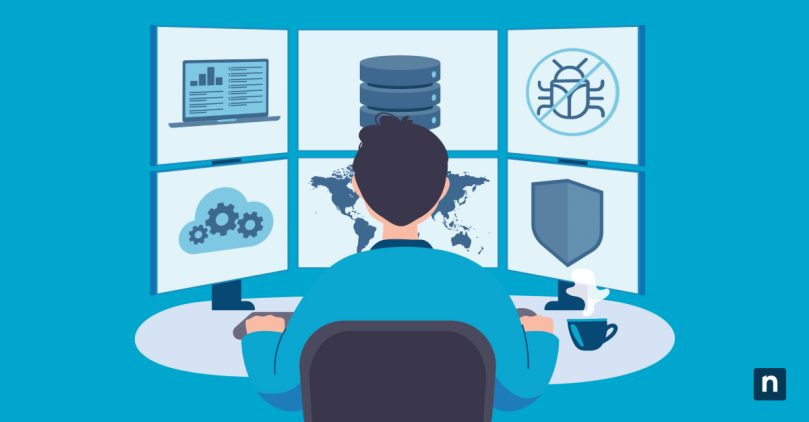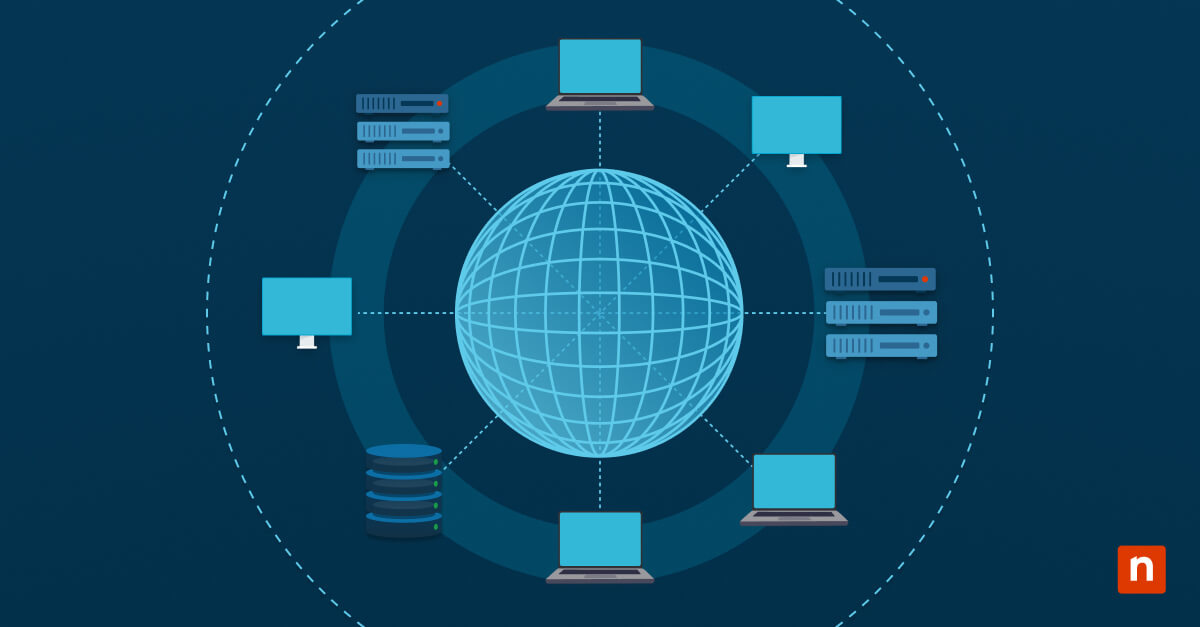IT teams are chronically overworked, and with the ever-increasing software vulnerabilities, cloud attack vectors, privacy regulations, and licenses to manage, the workload isn’t getting any lighter. To keep up, many IT professionals have implemented remote monitoring and management (RMM) systems, which allow them to automate basic and repetitive tasks, set up network and device monitoring with alerts, and remotely access client machines.
RMM systems have two components: the centralized, single pane of glass dashboard used by IT professionals and the RMM agent, which is the software installed on client devices to enable remote management. Whether you’re part of the IT department within your organization or an external Managed Service Provider (MSP), you know that proactivity is essential for keeping the organization functioning without interruption. By installing this agent on devices everywhere in the organization, you can stay on top of new developments, device inventory, and updates.
What is an RMM agent?
Simply defined, the RMM agent is the unobtrusive software that you install on the devices that you want to monitor. It creates the connection between the device used for management and the device being managed. Unlike a virtual agent, RMM does not use AI, but it can automate tedious processes. Here are several helpful features that an RMM agent provides:
- Automated Monitoring: Consistent monitoring of client hardware provides alerts and status updates for devices. You can also configure your RMM agent to inform you when a patch or update is needed and available.
- System Maintenance: An RMM agent can execute updates, patches, and software installations to reduce the workload for IT service teams. These basic tasks can be scheduled and run without direct intervention.
- Application Management: From your RMM dashboard, you can direct the agent to remotely install or uninstall applications from users’ devices. An added bonus of this capability is that you can do it without needing to interrupt the user’s workflow.
- Remote Assistance: If a user submits a ticket, you don’t need to drive to the location to fix the issue. The RMM agent allows you to connect to the device remotely, meaning you can view and control that device to solve the problem.
- Tracking Assets: Any device that has the agent installed can be tracked on the centralized dashboard, and you’ll also be able to monitor its health and position in the device lifecycle.
Benefits of RMM agents
- Monitoring and alerting: Real-time monitoring of servers, networks, and endpoints can help you quickly spot potential issues and begin problem-solving early. Rather than waiting to fix something when it breaks, IT technicians using RMM agents can address the issue before users are interrupted. Proactive alerting for performance issues, security threats, and system failures gives technicians time to prepare for a disaster and work to prevent it, which will minimize or eliminate downtime for the organization.
- Remote access and control: The ability to remotely access and control devices for troubleshooting and maintenance saves time and resources. And because a technician can access the machine without the user being aware, depending on the severity of the issue, remote access could allow the user to continue working normally without being interrupted or slowed down. If the user does need to stop using the device, he or she is free to do other things while the technician solves the problem with remote control. Issue resolution is quick and streamlined.
- Patch management and software deployment: Automating software updates and security patches across multiple devices gives IT technicians more time to focus on urgent or complex projects. Efficient deployment of software and applications keeps the organization’s daily operations running smoothly without eating up all of the IT team’s time.
- Asset management and inventory: The RMM agent enables tracking and managing of hardware and software assets, which means that all devices can be tracked by one department. IT Asset Management (ITAM) tools built into RMM solutions ensure that there is one single, accurate repository of information on the devices owned by the organization. The RMM agent also enables generating reports on system inventory, licenses, and warranties, which keeps renewals on schedule.
- Effective communication: Each RMM agent reports to the central dashboard, which helps IT providers keep tickets and projects organized and streamlines communication. The agents provide real-time status reports so that there is no time wasted waiting for a colleague to confirm whether a task is complete or on the schedule for the day.
RMM agent deployment and integration
RMM agents work with a variety of devices and operating systems, including Windows, macOS, Linux, and cloud-based. To begin using RMM solutions, first install RMM agents on all endpoints. The agents are coded to accumulate useful data and send a report on the health and status of the device. Information from all endpoints is gathered and displayed on the RMM dashboard.
Installing a NinjaOne agent on a user’s device is simple. You start in your NinjaOne RMM console, then click on the “+” button in the upper right corner. This opens a dropdown menu that will allow you to add a device, and then you’ll choose the operating system that the device runs. Finally, you’ll be able to generate an installer that can be sent as a link to the user, and the user will download it to the device.
Additionally, RMM agents can be integrated with many of the solutions you’re already using for tasks such as ticketing, helpdesk, anti-virus, team communication, and login authentication. For example, NinjaOne supports integrations with a large number of applications, from ConnectWise to Slack. This allows you to continue using the platforms that you like while gaining a centralized information center and remote connection capabilities that can streamline your activities and vastly improve your team’s efficiency.
Considerations for choosing an RMM agent
To find the right RMM agent for you, it’s important to consider a variety of factors.
- Scalability: Often, the organizations for which you provide support will change in size over time, so whatever solution you choose must be able to scale as needed. If the RMM solution that you are considering is designed to handle a small environment, but your client is about to acquire a company and double in size, the agents will be insufficient. Ideally, the RMM solution that you use will be infinitely scalable, so you don’t have to find a new one a few years down the road.
- Flexibility: Due to the varying needs of your team and clients, you should find a solution with a variety of functions that can be tailored to your operations. Your RMM agent should work on multiple operating systems and various types of endpoints. The vendor should also have support available to help you as needed.
- Ease of Use: When an RMM agent is installed, the tool will save you time and effort; however, you won’t maximize the benefits if the dashboard or interface is counterintuitive and frustrating. While shopping for the right RMM agent, be sure to request a demo of the product before purchase. The dashboard should be easy to use, and you should be able to easily follow along during the demo.
- Security and Compliance Features: Security and compliance are two of the most important aspects of good IT support, but they also have a lot of tasks that are time consuming but simple. This makes them great candidates for automation. Choose an RMM agent that can handle these tasks, monitor for available patches and updates, and alert you to anomalies that could indicate a security problem.
- Integration Capabilities and Supported Protocols: Devices and applications are growing more interconnected, and many organizations depend on Application Programming Interfaces (APIs) for smooth business operations. Be sure that the RMM agent you choose can handle security protocols and patching for your APIs and web applications. The RMM solution should also integrate with the applications you use for things like maintenance, asset management, ticketing, team communication, client communication, and login authentication.
- Self-Service Capabilities: Sometimes, a service request is very simple, but it isn’t necessarily something you can automate. For example, if an end user needs to restore a file, rather than reaching out to the IT team, he or she can do it through the RMM agent. This also saves you time and resources, and it takes one more thing off your plate. s
Best practices for RMM agent implementation
To get the most out of your RMM agent, be sure you’re following recommended best practices for RMM agent use, for limiting access to any integrated application, and for appropriate security hygiene. Here are some of the most important best practices to help you get started on the right track:
- Confirm Correct Configurations: Before you begin using RMM agents for monitoring or maintenance tasks, be sure to follow setup instructions carefully and to configure correctly. If everything is not exactly right, you could be missing vulnerabilities or alerts.
- Fine-tune: To take full advantage of your RMM agent, keep a close eye on alerts and monitor its performance for a few weeks after setup. As you have time, it pays to customize your settings to make sure your technicians are getting the most relevant information.
- Update Consistently: As you likely tell your clients, regular maintenance, patches, and updates are essential to secure and properly functioning software.
- Practice Good Security: Make sure that you’re following good security practices for your agent, including proper password creation and use, multi-factor authentication, and access controls. Because the RMM agent controls so many devices, it’s a major security risk to secure it poorly. As a rule, only those who need access to the agent should be able to access it, and you should delete any accounts or credentials that fall out of use.
See what G2’s no. 1 software for RMM can do for your business. Try NinjaOne RMM for free.
RMM agents are essential to effective and proactive IT infrastructure management
If you provide IT support, you know that waiting for something to break before you fix it isn’t the best course of action. To receive advance notice that something is wrong, install an RMM agent and deploy it to all client devices that you support. The agent can help streamline communication, organize tasks, and complete basic updates or installations to save you time and resources.
As IT environments become more complex, vulnerabilities, hardware problems, and help desk requests pop up all the time. In your organization, you may find yourself and your team stretched increasingly thin. RMM agents are essential to effective and proactive IT infrastructure management as they can automate and handle many of the basic tasks that you would normally do. This frees you to focus on more long-term projects and complex troubleshooting.
If you’re looking for a good option for an RMM agent, NinjaOne offers top-rated RMM software that can provide all of these advantages. NinjaOne is easy to use, offers an intuitive RMM dashboard, and focuses on improving your IT management efficiency. Overall, it’s an excellent option if you’re looking for an RMM agent with a variety of functions and capabilities.








